Railroads In California
 From Citizendium
From Citizendium 
In this Southern Pacific advertisement of 1876, California was already being depicted as a cornucopia, a symbol of abundance from classical antiquity that would have been reassuringly familiar to SPRR's intended audience.
The Railroads in California played a vital role in the State's early development as well as the explosive growth that followed. The establishment of America's transcontinental rail lines permanently linked California to the rest of the country, and the far-reaching transportation systems that grew out of them during the century that followed contributed immeasurably to the state’s unrivaled social, political, and economic development. When California was admitted to the Union in 1850, and for almost two decades thereafter, it sat isolated from all other states, the country’s lone outpost on the Pacific. Pioneers wishing to emigrate to the Gold Coast were faced with but three options: a four-month windjammer voyage around the Horn; an expedition through the malaria-infested jungles of Panama on horseback; or, an arduous weeks- or even months-long trek via stage coach, covered wagon, on horseback, or (in many cases) by foot across hundreds of miles of open desert and vast mountain ranges, risking Indian attack, starvation, and other hazards.
Transcontinental links[edit]
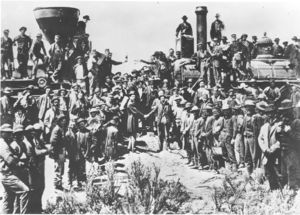
The "Golden Spike" ceremony held at Promontory Summit, Utah on May 10, 1869 in celebration of the completion of the First Transcontinental Railroad.[1]
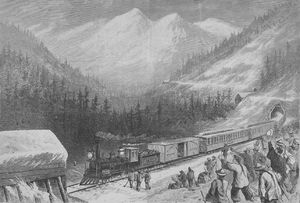
A winter scene with a Central Pacific Railroad train emerging from a snow shed in the Sierra Nevadas as Chinese workers cheer. Snow-covered hills and mountains can be seen in the distance.
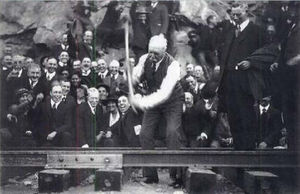
John D. Spreckels drives the "golden spike" to ceremonially complete his San Diego and Arizona Railway on November 15, 1919.[2]
California's symbolic and tangible connection to the East was fused at Promontory Summit, Utah, as the last spike was driven to join the tracks of the Central Pacific and Union Pacific Railroads, thereby completing the First Transcontinental Railroad on May 10, 1869 (before that time, only a few local rail lines operated in the State, the first being the Sacramento Valley Railroad).[3] The 1,600-mile (2,575-kilometer) trip cross-country from Omaha would now take mere days. The "Wild West" was quickly transformed from a lawless, agrarian frontier to what would become an urbanized, industrialized economic and political powerhouse. Of perhaps greater significance is the unbridled economic growth that was spurred on by the sheer diversity of opportunities available in the region.
The four years following the "Golden Spike" ceremony saw the length of track in the U.S. double to over 70,000 miles (nearly 113,000 kilometers).[4] By the turn of the century, the completion of four subsequent transcontinental routes in the United States of America and one in Canada would provide not only additional pathways to the Pacific Ocean, but would forge ties to all of the economically-important areas between the coasts as well. Virtually the entire country was accessible by rail, making a national economy possible for the first time. And while federal financial assistance (in the form of land grants and guaranteed low-interest loans, a well-established government policy) was vital to the railroads’ expansion across North America, this support accounted for less than eight percent (8%) of the total length of rails laid; private investment was responsible for the vast majority of railroad construction.[5]
As rail lines pushed further and further into the wilderness, they opened up huge acreages which would have otherwise lain fallow. The railroads helped establish countless towns and settlements, paved the way to abundant mineral deposits and fertile tracts of pastures and farmland, and created new markets for eastern goods. The Central Pacific Railroad, in effect, initiated the trend by offering settlement incentives in the form of low fares, and by placing sections of its government-granted lands up for sale to pioneers. It is estimated that by the end of World War II, rail companies nationwide remunerated to the government over $1 billion dollars, more than eight times the original value of the lands granted.[6] The principal commodity transported across the rails to California, however, was people: By reducing the cross-country travel time to as little as six days, men with westward ambitions were no longer forced to leave their families behind. The railroads would, in time, provide equally-important linkages to move the inhabitants throughout the state, interconnecting its blossoming communities.
When the Atchison, Topeka & Santa Fe Railway charted its own solo course across the continent in 1885 it chose Los Angeles as its western terminus, and in doing so fractured the Southern Pacific Railroad's near total monopoly on rail transportation within the state. The original purpose of this new line was to augment the route to San Diego, established three years prior as part of a joint venture with the California Southern Railroad, but the Santa Fe would subsequently be forced to all but abandon these inland tracks through the Temecula Canyon (due to constant washouts) and construct its Surf Line along the coast to maintain its exclusive ties to San Diego.[7] Santa Fe's entry into Southern California resulted in widespread economic growth and ignited a fervent rate war with the Southern Pacific, or "Espee" as the road was often referred to; it also led to Los Angeles' well-documented real estate "Boom of the Eighties." [8] The Santa Fe Route led the way in passenger rate reductions (often referred to as "colonist fares") by, within a period of five months, lowering the price of a ticket from Kansas City, Missouri to Los Angeles from $125 to $15, and, on March 6, 1887 to a dollar![9] The Southern Pacific soon followed suit and the level of real estate speculation reached a new high, with "boom towns" springing up literally overnight. Free, daily railroad-sponsored excursions (complete with lunch and live entertainment) enticed overeager potential buyers to visit the many undeveloped properties firsthand and (hopefully) invest in the potential of the land.
Unfortunately, as with the Comstock mining securities boom of the 1870s, Los Angeles' land boom attracted an unscrupulous element that often sold interest in properties whose titles were not properly recorded, or in tracts that did not even exist.[10] Major advertising campaigns by the SP, Santa Fe, Union Pacific, and other major carriers of the day not only helped transform southern California into a major tourist attraction but generated intense interest in exploiting the area's agricultural potential.[11] Word of the abundant work opportunities, high wages, and the temperate and healthful California climate spread throughout the Midwestern United States, and led to an exodus from such states as Iowa, Indiana, and Kansas; although the real estate bubble "burst" in 1889 and most investors lost their all, the Southern California landscape was forever transformed by the many towns, farms, and citrus groves left in the wake of this event.[12]
Historians James Rawls and Walton Bean have postulated that were it not for the discovery of gold in 1848, Oregon might have been granted statehood ahead of California, and therefore the first Pacific Railroad might have been built to that state, or at least been born to a more benevolent group of founding fathers.[13] This speculation lacks support, however, when one considers that a significant hide and tallow trade between California and the eastern seaports was already well-established, that the federal government had long planned for the acquisition of San Francisco, California Bay as a western port, and that suspicions regarding England's intentions towards potentially extending their holdings in the region southward into California would almost certainly have forced the government to embark on the same course of action.
While the completion of the First Transcontinental Railroad would rightfully be remembered as a major milestone in America's history, it would also foster the birth of a railroad empire that would have a dominant influence over California’s evolution for years to come. Despite all of the shortcomings, in the end the State reaped innumerable and unprecedented benefits from its associations with the railroad companies, which helped put California "on the map."
Agriculture[edit]

A special eastbound fast fruit prepares to depart a Central Pacific Railroad passenger station on June 24, 1886.

A crate label for Hewes' Transcontinental Brand of El Modena, California, circa 1930.[14]
Even today, California is well-known for the abundance and many varieties of fruit trees that are cultivated throughout the state. The only fruits indigenous to the region, however, consisted of wild berries or grew on small bushes. Spanish missionaries brought fruit seeds over from Europe, many of which had been introduced to the Old World from Asia following earlier expeditions to the continent; orange, grape, apple, peach, pear, and fig seeds were among the most prolific of the imports.
Mission San Gabriel Arcángel, fourth in the Alta California chain, was founded in 1771 near what would one day be the City of Los Angeles.[15] Thirty-three years later the mission would unknowingly witness the origin of the California citrus industry with the planting of the region’s first significant orchard, though the commercial potential of citrus would not be realized until 1841.[16] Several small carloads of California crops were shipped eastward via the new transcontinental route almost immediately after its completion, using a special type of ventilated boxcar modified specifically for this purpose. The advent of the iced refrigerator car or "reefer" led to increases in both the amount of product carried and in the distances traveled.
For years, the overall scarcity of oranges in particular led to the general perception that they were suitable only for holiday table decoration or as indulgences for the affluent. During the 1870s, however, hybridization of California oranges led to the creation of several flavorful strains, chief among these the Navel and Valencia varieties, whose development allowed for year-round cultivation of the fruit. Substantial foreign (out-of-state) markets for California citrus would come into full stature by 1890, initiating a period referred to as the "Orange Era." [17]
As the market for agricultural goods outside the state’s boundaries increased, the Santa Fe developed a massive fleet of refrigerator dispatch cars, and in 1906 the Southern Pacific joined with the Union Pacific Railroad to create the Pacific Fruit Express.[18] Fully half the farm products produced in California could now be exported throughout the country, with western railroads carrying virtually all of the perishable fruit traffic.[19] The western states of California, Arizona, and Oregon would dominate U.S. agricultural production by the coming of the Great Depression; once such diverse and high-demand crops as wheat, sugar beets, olives, and lettuce were cultivated, California would become known as the nation’s "produce basket." [20]
Mass transit[edit]
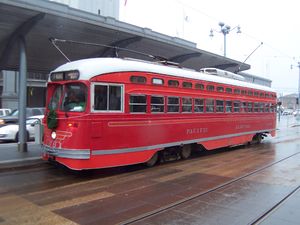
San Francisco Municipal Railway #1061, a rebuilt PCC streetcar painted in honor of the Pacific Electric Railway, is seen in service on the F Market & Wharves heritage line in December, 2004.[21]
"Transportation determines the flow of population," declared John D. Spreckels, one of California’s early railroad entrepreneurs, just after the dawn of the twentieth century. "Before you can hope to get people to live anywhere...you must first of all show them that they can get there quickly, comfortably and, above all, cheaply." [22] Among Spreckels' many accomplishments was the formation of the San Diego Electric Railway in 1892, which radiated out from downtown to points north, south, and east and helped urbanize what was previously a sleepy fishing village. Major rail-based mass transit systems (both extant and defunct) include:
- The Bay Area Rapid Transit system (BART), a heavy-rail rapid transit system that has served the San Francisco Bay Area since 1972.
- The Los Angeles Railway, which operated from 1901–1963, commonly known as the "Yellow Car" system, and later the Los Angeles Transit Lines. The system operated streetcars throughout central Los Angeles and surrounding neighborhoods.
- Metro Rail, a rapid-transit rail system that has served communities throughout Los Angeles County since its icenption in 1990. Interconnection is provided with the Metro transitway bus system as well as the Metrolink commuter rail systems.
- The Pacific Electric Railway (reporting mark PE), which operated from 1901–1961, commonly known as the "Red Car" system. At its peak the largest electric railway in the world, the system (founded by Henry Huntington, the nephew of Central Pacific Railroad founder Collis P. Huntington) utilized a combination of streetcars, light rail, and buses to connect cities throughout Southern California in Los Angeles, Orange, Riverside, and San Bernardino counties.
- The aforementioned San Diego Electric Railway, which operated from 1892–1949 (reporting mark (SDER). The system utilized streetcars (and in later years, buses) covering routes throughout San Diego County.
- The San Diego Trolley, a light rail system operating in the metropolitan areas of San Diego. Known colloquially as "The Trolley," the system has operated continuously since 1981.
- The San Francisco Municipal Railway, also known as the "Muni," is the public transit system for the city and county of San Francisco, California. The system, whose network includes bus, trolley, light rail, subway, and cable car lines, is integrated with the local regional transportation services including the Bay Area Rapid Transit system, SamTrans, and AC Transit. Muni has been in operation since 1912.
Oil boom[edit]
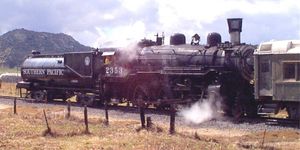
Restored Southern Pacific Lines No. 2353, a 4-6-0 oil-burning steam locomotive built by the Baldwin Locomotive Works in 1912. The cylindrical tender, specifically designed to carry fuel oil, was a signature feature of the railroad.
With the expansion of agriculture interests throughout the state (along with new rail lines to carry the goods to faraway markets), new communities were founded and existing towns expanded. Agrarian successes led to the establishment of post offices, schools, churches, mercantile outlets, and ancillary industries such as packing houses. The discovery of brea, more commonly referred to as tar, in Southern California would lead to an oil boom in the early twentieth century. Railroad companies soon discovered that shipping wooden barrels loaded with oil via boxcars was not cost-effective, and developed steel cylindrical tank cars capable of transporting bulk liquids virtually anywhere. By 1915, the transportation of petroleum products had become a lucrative endeavor for western railroads.[23]
Most oil tank cars would remain in revenue service for decades until the "Black Bonanza" had run its course. The Southern Pacific is credited with being the first western railroad to experiment in 1879 with the use of oil in its locomotives as a fuel source in lieu of coal (with substantial technical assistance from the Union Oil Company, one of the SP’s biggest accounts).[24] By 1895, oil-burning locomotives were in operation on a number of Southern Pacific routes, and on the competing California Southern and Great Northern Railway as well.[25] This innovation not only allowed the SP (and other railroads that soon followed their example) to benefit from the use of this abundant and economically-viable fuel source, but to create new markets by capitalizing on the burgeoning petroleum industry. The conversion from coal to oil also help solved the Southern Pacific's problem of intense smoke in the tunnels of the Sierra Nevada Mountains. Thanks to the railroads, California was once again thrust into the limelight.
Tourism[edit]

Ventriloquist Edgar Bergen and his "sidekick" Mortimer Snerd pose in the cab of Santa Fe #51L, lead locomotive on the Super Chief, in 1946.[26]
As has been previously discussed, the railroads were among the first to promote California tourism as early as the 1870s, both as a means to increase ridership and to create new markets for the freight hauling business in the areas they served.[27] Some sixty years later, the Santa Fe would lead a resurgence in leisure travel to and along the west coast aboard such "named" trains as the Chief and later the Super Chief; the Southern Pacific would soon follow suit with their Golden State and Overland trains, and the Union Pacific with its City of Los Angeles and City of San Francisco. But it can be said that only the Santa Fé embraced the aura of the American Southwest so completely in its advertising campaigns as well as its operations. The AT&SF routes and the extraordinary level of service provided thereon became particularly popular with stars of the film industry in the thirties, forties and fifties, both building on and adding to the Hollywood mystique. The "golden age" of railroading would eventually end as travel by automobile and airplane became more cost-effective, and popular.
Corruption and scandal[edit]
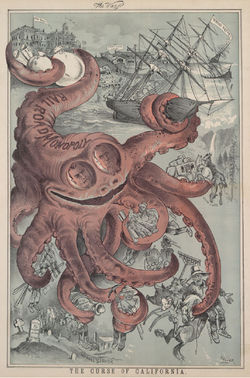
"The Curse of California" appeared in San Francisco's The Wasp on August 19, 1882. The illustration portrays the powerful Southern Pacific Railroad monopoly as an octopus, with the State's various financial interests wrapped within its many tentacles.
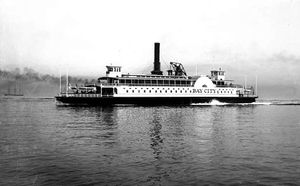
The Southern Pacific Company's Bay City ferry plies the waters of San Francisco Bay in the late 19th century.[28]
In 1901, Frank Norris vilified the Southern Pacific for its monopolistic practices in his acclaimed novel The Octopus: A Story of California; John Moody’s 1919 work The Railroad Builders: A Chronicle of the Welding of the States referred to "the American railroad problem" wherein the men who rode the iron horse were characterized as "monsters" that too often suppressed government reform and economic growth through political chicanery and corrupt business practices.[29]
While it is true that much of the traveling public would have been unable to make the trip to California's sunny clime were it not for the fleet, relatively safe, and affordable trains of the western railroads, it is also true that those companies in effect preyed on those same settlers once they arrived at the end of the line. For instance, while the railroads provided much-needed transportation routes to out-of-state markets for locally-produced raw materials and avenues of the import for eastern goods, there were numerous instances of rate fixing schemes among the various carriers, the Santa Fe and Southern Pacific included.[30] Opposition to the railroads began early in Southern California's history due to the questionable practices of The Big Four in conducting the business of the Central (later Southern) Pacific. The Central Pacific Railroad (and later the Southern Pacific) maintained and operated whole fleets of ferry boats that connected Oakland with San Francisco by water. Early on, the Central Pacific gained control of the existing ferry lines for the purpose of linking the northern rail lines with those from the south and east; during the late 1860s the company purchased nearly every bayside plot in Oakland, creating what author and historian Oscar Lewis described as a "wall around the waterfront" that put the town’s fate squarely in the hands of the corporation.[31] Competitors for ferry passengers or dock space were ruthlessly run out of business, and not even stage coach lines could escape the group's notice, or wrath.
Competition between carriers for rail routes was fierce as well, and unscrupulous means were often used to gain any advantage over one another. Santa Fe work crews engaged in sabotage to slow the progress of the Denver & Rio Grande Railroad through the Sierra Nevadas as the two fought their way toward the Coast; the Santa Fe (in conjunction with the California Southern) would win the race in establishing its connection to Bakersfield in 1883. Some eleven years earlier, the Southern Pacific essentially blackmailed the then-fledgling City of Los Angeles into paying a hefty subsidy to ensure that the railroad’s north-south line would pass through town; in 1878, the company would be rebuffed in its attempts to extend its Anaheim branch southward to San Diego through Orange County's Irvine Ranch without securing the permission of James Irvine, Sr., a longtime rival of Collis Huntington.[32] The Southern Pacific would similarly block the westward progress of the Santa Fe (known to some as the “People's Railroad”) until September 1882, when a group of enraged citizens ultimately forced the railroad's management to relent.[33] Numerous accounts of similar "frog wars" and other such tactics have been recorded throughout California's railroad history.
Perhaps the most notorious examples of impropriety on the part of the railroads surround the process of land acquisition and sales. Since the federal government granted to the companies alternate tracts of land that ran along the tracks they had laid, it was generally assumed that the land would in turn be sold at its fair market value at the time the land was subdivided; circulars distributed by the SP (which was at the time a holding company formed by the Central Pacific Railroad) certainly implied as much. However, at least some of the tracts were put on the market only after considerable time had passed, and the land improved well beyond its raw state.[34]
Families faced with asking prices of ten times or more of the initial value more often than not had no choice but to vacate their homes and farms, in the process losing everything they worked for; often it turned out to be a railroad employee who had purchased the property in question. A group of immigrant San Joaquin Valley farmers formed the Settlers' League in order to challenge the Southern Pacific's actions in court, but after all of the lawsuits were decided in the favor of the railroads, one group decided to take matters into their own hands. What resulted was the infamous Battle at Mussel Slough, in which armed settlers clashed with railroad employees and law enforcement officers engaged in eviction proceedings. Six people were killed in the ensuing gunfight.[35] The Southern Pacific would emerge from the tragedy as the prime target of journalists such as William Randolph Hearst, ambitious politicians, and crusade groups for decades to follow.[36] Leland Stanford's term as Governor of California (while still serving on the SP's board of directors) enhanced the corporation's political clout, but simultaneously further increased its notoriety as well.
Regulation[edit]
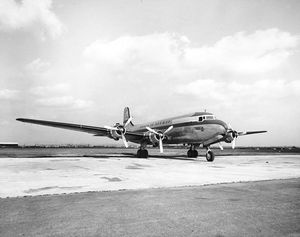
The Atchison, Topeka & Santa Fe Railway operated a fleet of Douglas DC3 and DC4 aircraft known as the Santa Fe Skyway until the U.S. federal government forced the company out of the airline business.
Public response to the corruption that arose from California's economic "explosion" led to the enactment of numerous reform and regulation measures, many of which coincided with the ascendancy of the Populist and Progressive movements. Early examples of railroad regulation include Granger case decisions in the 1870s, and the creation of an (albeit ineffective) Railroad Commission via amendment of the State's Constitution of 1879. In 1886, the U.S. Supreme Court ruled against Santa Clara County in Santa Clara County v. Southern Pacific Railroad. The Court declared that a corporation henceforth could be considered an American citizen, with all the associated immunities and privileges (except the right to vote). The Court's finding made it difficult for states to pass legislation that could make corporations accountable to the people. The Stetson-Eshelman Act of 1911 provided for the fixing of shipping rates by state legislatures.
Notes[edit]
- ↑ At center left Samuel S. Montague of the Central Pacific Railroad shakes hands with Grenville M. Dodge of the Union Pacific Railroad (center right). As an aspect of the racism of the time, the Chinese railroad laborers present during the construction were not allowed to be photographed in the ceremony.
- ↑ Kimball: "Spreckels made a short speech from a flat car, jumped down, stripped off his coat and drove the final spike. A thousand spectators observed."
- ↑ Daniels, p. 53
- ↑ Daniels, p. 54
- ↑ Daniels, p. 55
- ↑ Robinson, p. 157
- ↑ Duke, p. 43
- ↑ Donaldson and Myers, p. 58
- ↑ Duke and Kistler, p. 32
- ↑ Beebe, p. 240
- ↑ Rawls and Bean, p. 207
- ↑ Duke and Kistler, p. 32
- ↑ Rawls and Bean, p. 112
- ↑ A Pacific Fruit Express train can be seen passing close to San Francisco and several of the Bay Area's most identifiable landmarks.
- ↑ Wright, p. 25
- ↑ Thompson, p. 341
- ↑ Thompson, p. 342
- ↑ Daniels, p. 94
- ↑ Duke, p. 403
- ↑ Thompson, p. 343
- ↑ This single-ended car was originally built for the City of Philadelphia in 1946 (Pacific Electric only operated double-ended PCC's).
- ↑ Dodge, p. 18
- ↑ Duke, p. 404
- ↑ Duke, p. 432
- ↑ Yenne, p. 53
- ↑ The unit was one of several placed on public display at Los Angeles' Exposition Park prior to entering regular service.
- ↑ Duke and Kistler, p. 60
- ↑ The Southern Pacific owned the world's largest ferry fleet (which was subsidized by other railroad activities), at its peak carrying 40 million passengers and 60 million vehicles annually aboard 43 vessels.
- ↑ Moody, p. 237
- ↑ Lewis, p. 366
- ↑ Lewis, p. 371
- ↑ Donaldson and Myers, p. 14
- ↑ Donaldson and Myers, p. 43
- ↑ Yenne, p. 31
- ↑ Daniels, p. 59
- ↑ Yenne, p. 74
Categories: [Suggestion Bot Tag]
↧ Download as ZWI file | Last modified: 10/09/2024 22:33:30 | 2 views
☰ Source: https://citizendium.org/wiki/Railroads_in_California | License: CC BY-SA 3.0

 KSF
KSF